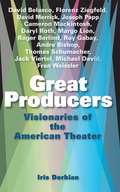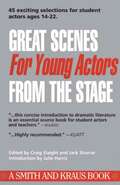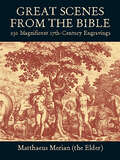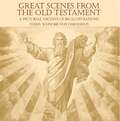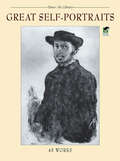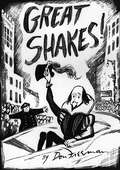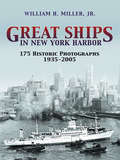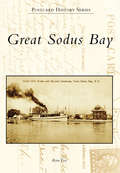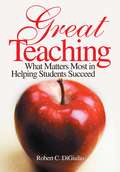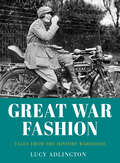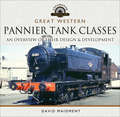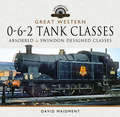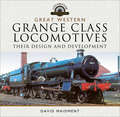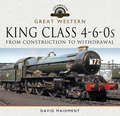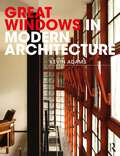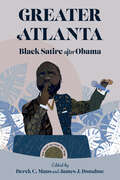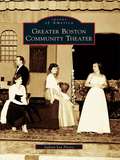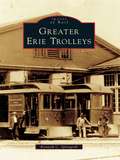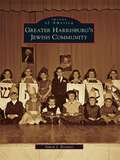- Table View
- List View
Great Producers: Visionaries of American Theater
by Iris DorbianUp close and personal with Broadway's brightest lights of the past, present, and future. * Firsthand accounts, rare interviews, backstage anecdotes * Insider ideas from Disney, Jujamcyn, Mackintosh, Weissler, Papp, Merrick, Ziegfeld, more! Meet the movers and shakers who shape what we see on Broadway. In this insider's look at the producers behind the shows, Broadway's most esteemed visionaries tell all--how they got started in the business, how they chose projects, how they raise money, and more.
Great Reckonings in Little Rooms: On the Phenomenology of Theater
by Bert O. StatesThis is a book about the theater phenomenon. It is an extension of notes on the theater and theatergoing that have been accumulating for some time. It does not have an argument, or set out to prove a thesis, and it will not be one of those useful books one reads for the fruits of its research. Rather, it is a form of critical description that is phenomenological in the sense that it focuses on the activity of theater making itself out of its essential materials: speech, sound, movement, scenery, text, etc. Like most phenomenological description, it will succeed to the extent that it awakens the reader's memory of his own perceptual encounters with theater. If the book fails in this it will be about as interesting to read as an anthology of someone else's dreams. In any case, this book is less concerned with the scientific purity of my perspective and method than with retrieving something from the theater experience that seems to me worthy of our critical admiration.
Great Rides of Today's Wild West: A Horseman's Photographic Journey Across the American West
by Mark BedorVeteran travel writer, photographer, and horseman Mark Bedor returns with another breathtaking adventure across the American West. This gorgeous photographic collection showcases twenty-six horseback rides across the United States (with one trip abroad to the great Australian Outback). For each, Bedor offers firsthand descriptions of the people and places, whether they’re tagging along on a cattle drive, taking part in a re-creation of Custer’s Last Stand, or just soaking in the natural vistas. Take part in the Great American Horse Drive in Colorado; ride through the spectacular Sierra Nevada at Inyo National Park; and step back in time to the Old West at Tombstone Monument Ranch. Whether the locations are working dude ranches, historic national parks, or world-famous travel destinations, Great Rides of Today’s Wild West shows them in full splendor through more than three hundred spectacular photographs by the author. The beauty, romance, and history of the Wild West and magnificent natural landscapes attract people from all over the world. This book lets you saddle up and ride across the country and beyond on some of the finest trails of today’s Wild West.
Great Scenes For Young Actors From The Stage (Young Actors Ser.)
by Craig Slaight Jack SharrarGreat Scenes for Young Actors (Young Actors Series)
Great Scenes from the Bible: 230 Magnificent 17th-Century Engravings (Dover Pictorial Archive)
by Matthaeus MerianRemarkably detailed illustrations depict Adam and Eve Driven Out of the Garden of Eden, The Flood, David Slaying Goliath, Christ in the Manger, The Raising of Lazarus, The Crucifixion, and many other scenes. A wonderful pictorial dimension to age-old stories. All 230 plates from the classic 1625 edition.
Great Scenes from the Old Testament: A Pictorial Archive of 160 Illustrations (Dover Pictorial Archive)
by Julius Schnorr von CarolsfeldOne of the most inspired painters of the nineteenth century, Julius Schnorr von Carolsfeld (1794 -1872) was also a brilliant engraver and draftsman. This collection, among his major accomplishments, includes scores of engravings that bring to life familiar scenes from the Old Testament - from the creation of the world and the fall of Adam and Eve to the story of Noah and his Ark and David's slaying of Goliath. Imbued with a sense of grace and spontaneity, Schnorr von Carolsfeld's monumental compositions pay minute attention to detail. Each of the 160 beautifully composed images, selected from a rare nineteenth-century publication, is accompanied by a caption citing title and biblical book and chapter.An important reference for students and scholars of scriptural studies, this handsome archive will also serve as an important sourcebook for designers and commercial artists.
Great Self-Portraits
by Carol Belanger GraftonWhat does a self-portrait tell us about the artist? Readers are invited to find out in this unique addition to Dover's popular Art Library Series. Drawings in pen, ink, and charcoal, as well as etchings and engravings, encompass 45 splendid self-portraits. Subjects range from such 15th-century artists as Gentile Bellini, Leonardo da Vinci, and Albrecht Dürer to a host of 19th-century masters: James Whistler, Auguste Rodin, Vincent van Gogh, Berthe Morisot, Aubrey Beardsley, and many more. Among the other artists depicted here is the avid self-portraitist Rembrandt van Rijn, in one of his trademark hats, along with Peter Paul Rubens, Francisco de Goya, William Blake, and Camille Pissarro. Artists, art historians and art lovers will enjoy discovering the emotions, character traits, and nuances of personality revealed in these masterly self-portraits.
Great Shakes
by Don FreemanIn simple yet all-telling black-and-white graphics, Freeman unfolds a humorous, lively, deeply human, and yet modern story of William Shakespeare being brought down from Heaven to help Hollywood out of a creative depression. Naturally, in a new environment, "Shakes" cannot produce hit material on call... and so his adventures begin – with humorous and deep consequences, all told without words! Enjoy Don Freeman's humour and his wonderful and sense of life with all of humanity' highs and lows and in-betweens.
Great Ships in New York Harbor: 175 Historic Photographs, 1935-2005
by William H. MillerA vibrant profile of New York Harbor, this illustrated chronicle traces the great port's history from its heyday in the 1930s to the present. Its informative text, complemented by 175 vintage photographs, conveys fascinating details in a conversational tone, making it as interesting to read as it is to browse.Great Ships in New York Harbor captures the bustling excitement of the busiest marine terminals in the world. It ranges from the elegant sophistication of the ships in the uptown piers known as Luxury Liner Row to the commercial hubbub of the downtown docks and their freighters, tramp steamers, tugs, and barges.Maritime expert William H. Miller, Jr., ranks among the best guides to the Port of New York. The author of numerous books on ships, he has traveled aboard all manner of vessels, often in the capacity of guest lecturer or journalist. Miller's books feature personal recollections and anecdotes from passengers who sailed on historic ships, and his unique selection of new and different pictures offers fresh perspectives on even the most-well-known vessels.
Great Sodus Bay (Postcard History)
by Rosa FoxGreat Sodus Bay graces the southern shore of Lake Ontario. Known as Bay of the Cayugas to early French explorers and Assorodus (Silvery Waters) to Native American Indians, Sodus Bay is bountiful in beauty and history. Host to many creative souls, entrepreneurs, and seekers of nature, relaxation, and recreation, Great Sodus Bay has captured the hearts of all who visit. The images in this volume provide a tour of the communities and commercial developments, as well as historic lighthouses, vintage boats, and architecture. Take a nostalgic look at Great Sodus Bay from 1890 to 1930--an era of newfound popularity as Sodus Bay developed into a destination resort.
Great Teaching: What Matters Most in Helping Students Succeed (1-off Ser.)
by Robert C. DiGiulioAmid the 'high-stakes’ climate of public education today, DiGiulio’s book reminds us of far more important outcomes than politicized test scores. Plain and simple, the book resonates with common sense.
Great War Fashion: Tales from the History Wardrobe
by Lucy AdlingtonImagine stepping into someone else’s shoes. Walking back in time a century ago, which shoes would they be? A pair of silk sensations costing thousands of pounds designed by Yanturni of Paris, or wooden clogs with metal cleats that spark on the cobbles of a factory yard? Would your shoes be heavy with mud from trudging along duckboards between the tents of a front-line hospital or stuck with tufts of turf from a football pitch? Would you be cloaked in green and purple, brandishing a ‘Votes for Women’ banner, or would you be respectably dressed, restricted by your thigh-length corset? Great War Fashion opens the wardrobe of women in the years before the outbreak of war to explore the real woman behind the stiff, mono-bosomed ideal of Edwardian society, and closes it on a new breed of women who have donned trousers and overalls to feed the nation and work in munitions factories and who, clad in mourning, have loved and lost a whole generation of men. The journey through Great War Fashion is not just about the changing clothes and fashions of the war years – it is a journey into the lives of the women who lived under the shadow of war and were irrevocably changed by it. Using material from her own extensive collection, renowned costume expert Lucy Adlington brings an inspiring generation of women to life with rare and stunning images alongside a narrative that is both deeply poignant and laugh-out-loud funny.
Great Western Pannier Tank Classes: An Overview of Their Design & Development (Locomotive Portfolios)
by David MaidmentThis comprehensive and fully illustrated history presents an in-depth look at the Great Western Railway&’s various pannier tank engines. Though hauling freight was a vital part of Great Western Railway&’s history—and where it made the majority of its profit—there are few books devoted to the stout, powerful engines that did the work. In Great Western, Pannier Tank Classes, British Railways expert David Maidment corrects that oversight. This volume explores the large number of 0-6-0 saddle tanks built for both the Great Western Railway and the independent railway companies in South Wales, most of which were converted to pannier tanks in the Churchward and Collett eras. While covering the Armstrong and Dean engines in detail, Maidment goes on to describe the design, construction and operation of the largest class of steam engines built in the UK in the last century: Charles Collett&’s GWR 5700 class, examples of which were still being built after nationalization. Collett also designed pannier tank engines for branch passenger and freight work, and his successor Frederick Hawksworth continued the GW tradition with a tapered boiler version. All of these are discussed in depth in terms of their design and service. A concluding chapter covers further designs that were never built.
Great Western Pannier Tank Classes: An Overview of Their Design & Development (Locomotive Portfolios)
by David MaidmentThis comprehensive and fully illustrated history presents an in-depth look at the Great Western Railway&’s various pannier tank engines. Though hauling freight was a vital part of Great Western Railway&’s history—and where it made the majority of its profit—there are few books devoted to the stout, powerful engines that did the work. In Great Western, Pannier Tank Classes, British Railways expert David Maidment corrects that oversight. This volume explores the large number of 0-6-0 saddle tanks built for both the Great Western Railway and the independent railway companies in South Wales, most of which were converted to pannier tanks in the Churchward and Collett eras. While covering the Armstrong and Dean engines in detail, Maidment goes on to describe the design, construction and operation of the largest class of steam engines built in the UK in the last century: Charles Collett&’s GWR 5700 class, examples of which were still being built after nationalization. Collett also designed pannier tank engines for branch passenger and freight work, and his successor Frederick Hawksworth continued the GW tradition with a tapered boiler version. All of these are discussed in depth in terms of their design and service. A concluding chapter covers further designs that were never built.
Great Western, 0-6-2 Tank Classes: Absorbed & Swindon Designed Classes (Locomotive Portfolios)
by David MaidmentDescriptions and hundreds of photos of these tank engines that played a major role in Welsh coal mining and passenger rail.After tackling the Great Western Railway’s pannier tanks in a previous Locomotive Portfolios volume, David Maidment seeks out descriptions and photographs of the GW 0-6-2 tank engines, the majority of which were built by the Rhymney, Taff Vale, Barry, and other Welsh railways from the last decade or so of the nineteenth century onward. The engines of eight different companies, absorbed by the GWR in 1922, are described and illustrated, as well as the way in which many were modernized and rebuilt at Swindon or Caerphilly Works in the 1920s. GWR Chief Mechanical Engineer Charles Collett was, however, faced with a motive power crisis in the mining valleys at the Grouping, as many of the companies had economized on essential maintenance as the GW’s takeover drew near, and he had to hurriedly design a standard 0-6-2T to complement and bolster their work as the powerful GW 2-8-0Ts were too heavy and wide for many of the Cardiff valleys. These engines, the 56XX & 66XX classes, became part of the South Wales scene between 1925 and 1964, mainly running the coal traffic between pits and docks, although they dominated Cardiff Valley passenger services until the influx of BR 3MT 2-6-2Ts and GW 41XX 2-6-2Ts in 1954 and 1955. With around 300 black & white photographs, this book takes a wide-ranging look at these locomotives.
Great Western, 0-6-2 Tank Classes: Absorbed & Swindon Designed Classes (Locomotive Portfolios)
by David MaidmentDescriptions and hundreds of photos of these tank engines that played a major role in Welsh coal mining and passenger rail.After tackling the Great Western Railway’s pannier tanks in a previous Locomotive Portfolios volume, David Maidment seeks out descriptions and photographs of the GW 0-6-2 tank engines, the majority of which were built by the Rhymney, Taff Vale, Barry, and other Welsh railways from the last decade or so of the nineteenth century onward. The engines of eight different companies, absorbed by the GWR in 1922, are described and illustrated, as well as the way in which many were modernized and rebuilt at Swindon or Caerphilly Works in the 1920s. GWR Chief Mechanical Engineer Charles Collett was, however, faced with a motive power crisis in the mining valleys at the Grouping, as many of the companies had economized on essential maintenance as the GW’s takeover drew near, and he had to hurriedly design a standard 0-6-2T to complement and bolster their work as the powerful GW 2-8-0Ts were too heavy and wide for many of the Cardiff valleys. These engines, the 56XX & 66XX classes, became part of the South Wales scene between 1925 and 1964, mainly running the coal traffic between pits and docks, although they dominated Cardiff Valley passenger services until the influx of BR 3MT 2-6-2Ts and GW 41XX 2-6-2Ts in 1954 and 1955. With around 300 black & white photographs, this book takes a wide-ranging look at these locomotives.
Great Western, Grange Class Locomotives: Their Design and Development (Locomotive Portfolios)
by David MaidmentThe renowned British railroad historian delivers &“a well-illustrated account of the rationale behind Collett&’s construction of this 80 strong class&” (West Somerset Railway Association). English railway engineer George Jackson Churchward proposed a 5ft 8in wheeled 4-6-0 for mixed traffic duties in 1901 and it was seriously considered in 1905, but it took until 1936 before his successor, Charles Collett, realized the plan by persuading the GWR Board to replace many of the 43XX moguls with modern standard mixed traffic engines that bore a remarkable likeness to the Churchward proposal. David Maidment has written another in his series of &“Locomotive Portfolios&” for Pen & Sword to coincide with the construction of a new &“Grange&” at Llangollen from GW standard parts to fill the gap left by the total withdrawal and scrapping of one of that railway&’s most popular classes—to their crews at the very least. As well as covering the type&’s design and construction, the author deals comprehensively with the allocation and operation of the eighty locomotives and in particular has researched their performance and illustrated it with many examples of recorded logs from the 1930s as well as in more recent times. As in previous volumes, the author has added his own personal experiences with the engines and has sourced more than 250 photos, over 40 of which are in color. &“Superbly researched . . . another extraordinary and unreservedly recommended addition to . . . British Railroading History collections.&” —Midwest Book Review &“Granges worked off-region quite widely, so this is not just a book for the copper-capped chimney brigade; enthusiasts for whom these capable machines are favorites will definitely want this volume on the bookshelf.&” —Railway Modeller
Great Western, King Class 4-6-0s: From Construction to Withdrawal (Locomotive Portfolios)
by David MaidmentAn in-depth look at the British railway company’s celebrated class of steam locomotives, with more than three hundred photos.Built by Collett in 1927 after pressure to restore the Great Western Railway’s pre-eminence in motive power and cope with increasing postwar traffic to Devon and Cornwall holiday resorts, the thirty Kings were the final development of the Churchward Stars and the 1923 Castles and remained on top-link main line duty until their final replacement by the ‘Western’ class 52 diesel hydraulics in 1962. This book includes an insight into the thinking of some of Collett’s senior staff at the end of the 1930s and the eventual transformation in the latter years with redraughting and double chimneys. As well as describing their design and construction, the book comprehensively covers their operation and performance, backed up by many recorded logs on all main GW/WR routes over which they were permitted. The author had close experience of the class when working at Old Oak Common between 1957 and 1962, and includes a chapter of his experiences with them, including many footplate trips (as a management trainee, he was greeted with glee by firemen who would hand him the shovel). The book also includes over 300 photographs, one hundred of them in color.
Great Windows in Modern Architecture
by Kevin AdamsWindows are moments in modern architecture where we look to ascertain elegance, technical expression and material language or to capture a certain atmosphere. A window opening is as much an interval and an opportunity as it is a device for admitting light, air or views; it is simultaneously a physical aperture but also a philosophical opening of collaboration and reflection. In order to understand the language of a building we might look to the detail of the window. But what does this mean and why does modern architecture invest so much expression in the window?This book explores how the act of detailing and situating windows in buildings is a key proponent in the language of architecture, which both informs and works with the contingencies of design and construction. It investigates 18 case studies in-depth using painstakingly drawn details and vivid photographs in full colour to define what makes these windows “great” and how each window is situated within both its technical and philosophical context and as an overall development of modern architecture.Case studies include the work of Walter Gropius, Mies van der Rohe, Pierre Chareau, Frank Lloyd Wright, Alvar Aalto, Carlo Scarpa, Le Corbusier, Stirling and Gowan, Raili and Reima Pietilä, Louis Kahn, Peter Womersley, Miralles/Pinós, Steven Holl, Glen Murcutt and O’Donnell + Tuomey.
Great Woodcuts of Albrecht Dürer
by Albrecht Durer Carol Belanger GraftonA master of many media, Albrecht Dürer (1471-1528) excelled in the art of woodcut design. This modestly priced edition, comprising images both sacred and secular, offers an ideal introduction to his work. Scenes from the lives of Jesus and the saints and episodes from the Old Testament appear alongside a variety of subjects, including a portrait of the Emperor Maximilian and Dürer's coat of arms. The ninety-four black-and-white illustrations feature brief captions with basic information regarding titles and dates. Long treasured by the world's art lovers, these familiar and lesser-known woodcuts are reproduced in excellent detail. They constitute an indispensable archive for professional art historians and critics as well as a source of pleasure for all others.
Great Yachts of Long Island's North Shore
by Robert B. MackayAt the turn of the 20th century, Long Island's North Shore, the so-called Gold Coast, was becoming the most desirable residential area in the United States. Estates belonging to American captains of finance and industry lined the bluffs and bays from the city line to Eaton's Neck. Some of the nation's most renowned families--including the Astors, Bakers, Huttons, Morgans, Pratts, Sloans, Roosevelts, Whitneys, and Vanderbilts--used their yachts for racing, cruising, commuting, or epic voyages. These vessels regularly plied the waters of the North Shore and bolstered the development of yacht clubs like the New York and Seawanhaka Corinthian--city institutions that established stations at Glen Cove and Centre Island, respectively. These clubs served to provide many outlets for the social gatherings that accompanied this pastime. Although the Great Depression and then World War II would bring the era of the great yachts to an end, a wealth of images remain that can be marveled at a century later.
Greater Atlanta: Black Satire after Obama
by Derek C. Maus and James J. DonahueContributions by GerShun Avilez, Lola Boorman, Thomas Britt, John Brooks, Phillip James Martinez Cortes, Derek DiMatteo, Tikenya Foster-Singletary, Alexandra Glavanakova, Erica-Brittany Horhn, Matthias Klestil, Abigail Jinju Lee, Derek C. Maus, Danielle Fuentes Morgan, Derek Conrad Murray, Kinohi Nishikawa, Sarah O'Brien, Keyana Parks, and Emily Ruth RutterThe seventeen essays in Greater Atlanta: Black Satire after Obama collectively argue that in the years after the widespread hopefulness surrounding Barack Obama’s election as president waned, Black satire began to reveal a profound shift in US culture. Using the four seasons of the FX television show Atlanta (2016–22) as a springboard, the collection examines more than a dozen novels, films, and television shows that together reveal the ways in which Black satire has developed in response to contemporary cultural dynamics. Contributors reveal increased scorn toward self-proclaimed allies in the existential struggle still facing African Americans today.Having started its production within a few weeks of Donald Trump’s (in)famous escalator ride in 2015, Atlanta in many ways is the perfect commentary on the absurdities of the contemporary cultural moment. The series exemplifies a significant development in contemporary Black satire, which largely eschews expectations of reform and instead offers an exasperated self-affirmation that echoes the declaration that Black Lives Matter.Given anti-Black racism’s lengthy history, overt stimuli for outrage have predictably commanded African American satirists’ attention through the years. However, more recent works emphasize the willful ignorance underlying that history. As the volume shows, this has led to the exposure of performative allyship, virtue signaling, slacktivism, and other duplicitous forms of purported support as empty, oblivious gestures that ultimately harm African Americans as grievously as unconcealed bigotry.
Greater Boston Community Theater
by Judson Lee PierceThe roots of community theater can be traced back to before the Revolutionary War. In the years that followed, many towns throughout America were fortunate to have both professional and amateur acting companies. The evolution of the moving picture forced many of these professional theaters to close their doors, but theater lovers in small communities still wanted the real thing, live theater. Today there are numerous community theater groups around the Boston area, including the oldest continuing community theater group in the country, the Footlight Club, which was founded in 1877. In the spirit of community, many theater companies donate to charities and sponsor playwriting contests and scholarship programs. They all share a common goal: bring live theater to suburban communities. Greater Boston Community Theater presents rare photographs from more than a dozen community theaters to document and celebrate the rich tapestry of theater life.
Greater Erie Trolleys
by Kenneth C. SpringirthWhen the first electric trolley car entered service in Erie in 1889, it revolutionized public transportation in the region. Within a few years, Erie became a major trolley hub linking the eastern and central United States. With the exception of a 15-mile gap at Little Falls, one could travel from New York City to Chicago via Erie. Greater Erie Trolleys covers the network of trolley lines that operated between Erie, Conneaut, Buffalo, and Meadville. Greater Erie Trolleys illustrates the vital role trolley cars played in the expansion of the urban population. It documents the beginning of pleasure travel with photographs of the special trolley car excursions from Erie to Elk Park for picnics, dances, and sporting events. Ridership began to decline just as the automobile came on the scene and dirt roads became paved highways. Eventually the lines were abandoned, but the trolleys left an important mark in transportation history.
Greater Harrisburg's Jewish Community (Images of America)
by Simon J. BronnerThe Jewish community of Greater Harrisburg became established after 1825, mostly by German immigrants who took up peddling and clothing trades. They were attracted inland from East Coast cities to Harrisburg, the growing upriver hub of trade that became Pennsylvania's state capital in 1812. The community grew to 600 residents by the end of the 19th century and drew attention for a level of civic engagement well beyond that of comparably sized settlements. Immigration from eastern Europe in the early 20th century contributed to a tenfold increase of the Jewish population and a changing ethnic and commercial profile. In the years that followed, the community added an impressive range of institutions and continued to have a reputation for activism. Emerging as the hub of Jewish life in central Pennsylvania, the community produced internationally renowned figures in Jewish affairs, business, and arts.
